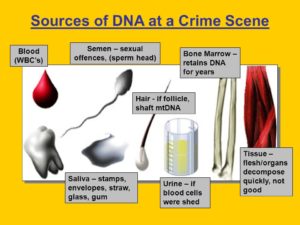
FORENSIC TOXICOLOGY
Basic Aspects in Forensic Toxicology related to Forensic Science in Biotechnology
INTRODUCTION
Forensic toxicology can be identified as a vast area on forensic science, which deals with the harmful toxigenic chemicals, harmful aspects of poisons and various other toxic substances that can effect on humans and animals. It is a multidisciplinary field which is able to detect presence of drugs in living tissues. ‘Toxicology’ can be defined mainly as the science of poison and also a branch in chemistry which is used for analysis and for the identification of toxic substances in a particular chemical. Chemicals that present in living organisms are used to test according to toxicological equipment. After analyzing process these results are defensible in court for further investigations.

Forensic toxicology is dynamic fields which enhance with different new technological applications such as Tandem Mass Spectrometry Methods, Particular Liquid Chromatography – Tandem Mass Spectrometry, Time of Flight Mass Spectrometry are some of them. These technologies are sensitive and efficient in the use of different searches in detecting more polar quantities of compounds, larger molecules and etc. With the rise of pharmacogenomics in the world, the toxicology also have a dramatically alter in interpretation of drug species and concentrations because various criminal cases are dependent on pharmacogenomics crimes. They are identified due to the genotypic and phenotypic changes due to the dosage and their metabolic capacity in the cells.
Applications of Forensic Toxicology
Forensic investigations are done according to the residual evidences of a crime. Therefore, biological materials such as blood, viscera, urine and hair are the major perceptions of evidences.
In forensic toxicology, they examine the remained substances after a crime scene such as medicinal capsules, tablets, pills and other vials to analyze the chemical quantity and concentration. Also to check whether, the offender has used those medications in order to commit the criminal or to find out if they have contributed to the crime.
Forensic toxicology performs in the identification of alkaloids which are in plants such as croton, strychnine, nicotine and in other tissues. Toxigenic substances can cause deaths due to different poisoning hazards. Also use in the identification of alcohol quantity in the blood via testing blood and urine samples in cases like accidents and other criminals.

To determination of poisons contain in drinking water, food stuff, and snack materials are effectual criteria in forensic toxicology. It helps to distinguish the causative agents contained and how much of dose was there.
Also help in identifications of accidents such as animal bites, snake bites, scorpion, fishes, insects and other animal damages caused to living tissues and how it has spread over the body, how much toxigenic, how will it affect to the body and finally help in giving the solutions and possible medications due to the situation.
Another application is using in postmortem examining to identify the post mortem staining, odor released from the dead body, identifying natural orifices, bite marks and injections, skin contour, and etc.
Obtaining Toxicological Evidences
These evidences can be collected in two major types as biological and non-biological evidences. Biological material can be identified as, hair, blood, saliva, urine, teeth, bone, organs in the body, cerebrospinal fluid and etc. 
These evidences should be collected in a preservative manner with the use of glass bottles or paper envelops. Other substances like food should place in poly bags. All the sufficient materials, tissues should be collected in a protective way. Then they should be set with saturated saline but not with rectified spirit if there was a case of phenol or phosphorus poisoning, because it will cause damages to the tissues. In the instance of collecting evidences, blood and urine should place and preserve in sodium fluoride solutions. The quantities should be in their actual size, for example, when it comes to stomach; whole quantity of the content should be included. Finally all the bottles, poly bags and paper envelop should be sealed properly to prevent the external effects to the evidences and also preventing the evaporation of volatile poisons and preservative liquids used.

Common Separation and Identification Techniques
Steam distillation methods are used to extract volatile toxigenic agents and identify them with use of gas chromatography. When it comes to the non-volatile extractions, first they should be treated with suitable solvents and identify with the use of thin layer or gas chromatography techniques. Some other techniques are,
- High Performance Liquid Chromatography (HPLC)
- Gas Chromatography Combination with Mass Spectrometry (GC-MS)
- Radio Immune Assay (RIA)
- Enzyme Linked Immunosorbent Assay (ELIA)
CONCLUSION
This is the study of adverse effects on drugs that can damage the biological systems due to different chemicals. Results of experiments are used to check whether the offense have done with the use of any toxigenic medications or chemicals. Communicating the results obtained through biological evidences is more challenging role than getting the results. Because of that, juries and lawyers are unable to understand how the scientific investigation went through and how the forensic toxicologists attempted to the decision. Those processes are complex and difficult get understand by any other person. Therefore strong communication skills should important in expressing the results in a fair and clear manner to the court.
REFERENCES
- Kanojia, S., (n.d.). What is Forensic Toxicology? Applications, Sub-disciplines & Education. Retrieved from: https://sciencemonk.com/forensic-toxicology/ (Accessed 6 September 2021)
- Adatsi, F.K., (2014). Forensic Toxicology – Encyclopedia of Toxicology (Third and Second Edition). Retrieved from: https://www.sciencedirect.com/topics/pharmacology-toxicology-and-pharmaceutical-science/forensic-toxicology (Accessed 6 September 2021)
- Springs, C., (2021). Toxicology – American Academy of Forensic Sciences. Retrieved from: https://aafs.org/Home/Resources/Students/Sections/Toxicology.aspx (Accessed 7 September 2021)


